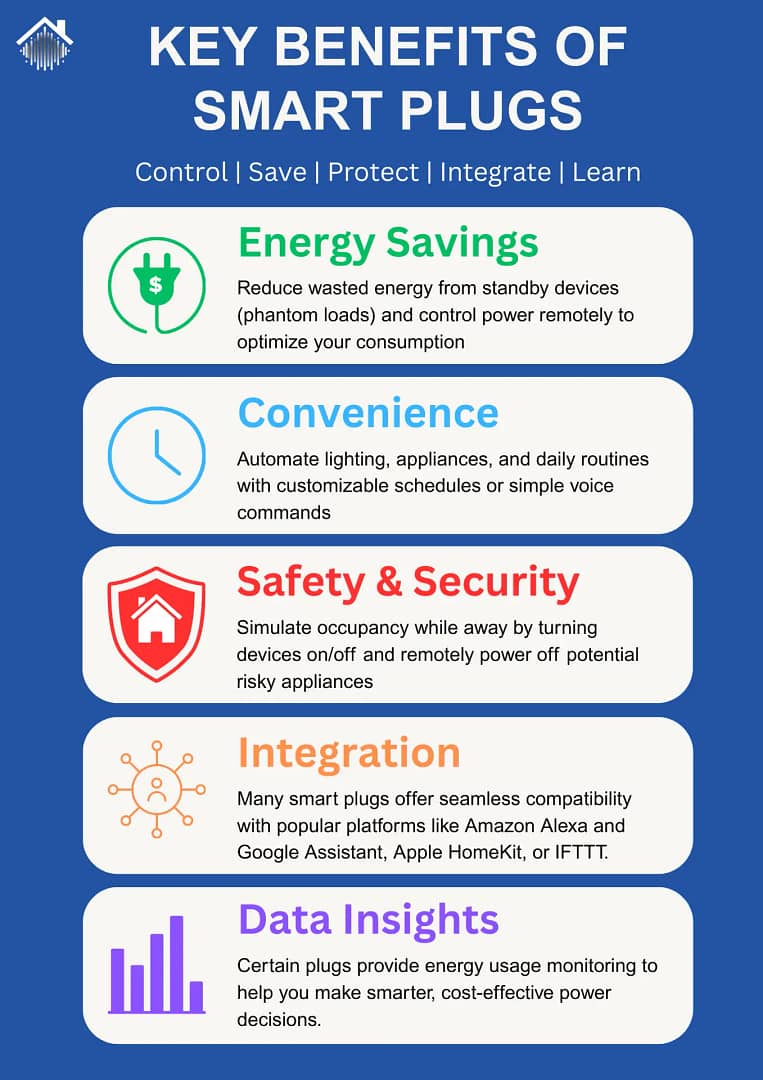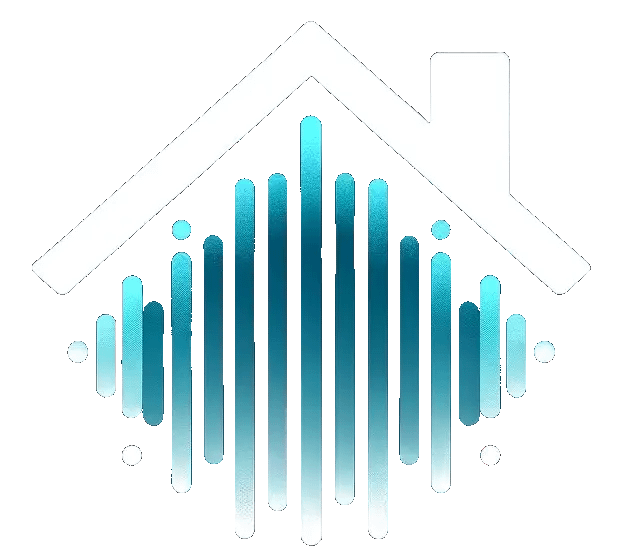Smart plugs offer an easy, affordable entry point into smart home automation. While they may not single-handedly reduce your entire energy bill by double digits, they are highly effective at lowering wasted energy from “phantom loads” and automating your daily routines with voice commands or schedules. If you think smart plugs are just for tech enthusiasts, think again — this simple upgrade brings convenience, safety, and energy savings to every home.
Why Should Smart Homeowners Care About Smart Plugs?
In today’s focus on sustainability, cost savings, and home convenience, smart plugs are quickly becoming essential components of connected home automation. Here’s why:
- Wasted electricity from “energy vampires” — devices like chargers and appliances left plugged in but not in use — can add a meaningful amount to your annual energy bill. Studies estimate phantom loads may account for 5-10% of household electricity usage.
- Manual management of multiple devices is time-consuming and easy to forget, leading to unnecessary energy waste.
- Smart plugs offer an affordable and DIY-friendly way to reduce waste, improve safety, and automate your home without costly installation.
This guide shows you how to make the most of smart plugs — maximizing energy efficiency, convenience, and value.
Key Benefits: Why Smart Plugs Deserve a Spot in Every Smart Home
- Energy Savings: Reduce wasted energy from standby devices (phantom loads) and control power remotely to optimize your consumption.
- Convenience: Automate lighting, appliances, and daily routines with customizable schedules or simple voice commands.
- Safety & Security: Simulate occupancy while away by turning devices on/off and remotely power off potentially risky appliances.
- Integration: Many smart plugs offer seamless compatibility with popular platforms like Amazon Alexa and Google Assistant. Some models also support Apple HomeKit or IFTTT, helping you expand your smart home ecosystem.
- Data Insights: Certain plugs provide energy usage monitoring to help you make smarter, cost-effective power decisions.

Unlocking Powerful Features: Smart Plug Pro Tips
1. Automate Routines for Effortless Living
Scheduling is a key feature of smart plugs. Program your coffee maker to start brewing before you get out of bed, or create lighting schedules that simulate occupancy when you’re away. This eliminates manual effort and enhances home security.
- Tip: Use the smart plug’s mobile app (e.g., Kasa Smart, TP-Link Kasa) to set daily or weekly routines. Many apps include “away modes” that randomize on/off times for improved security.
Real-life win: Set your porch lights to turn on at sunset and off at midnight automatically—now your evenings feel seamless, and you never have to worry about lights being left on.
2. Monitor Energy Usage and Optimize Savings
Some smart plugs have built-in energy monitoring which provides real-time and historical data on power consumption. This insight reveals which devices consume the most electricity so you can adjust usage or replace inefficient appliances.
- Action Step: Choose a smart plug with energy analytics. Check usage reports regularly and unplug or schedule power-hungry devices to save money.
3. Integrate with Your Smart Home Ecosystem
Integration unlocks your smart plug’s full potential. Most models support voice control and automation with platforms like Amazon Alexa and Google Assistant. Some also work with Apple HomeKit or IFTTT for more advanced control and connectivity.
- Connect your smart plug to 2.4GHz Wi-Fi (most do not support 5GHz)
- Enable the device in your preferred ecosystem’s app (Alexa, Google Home, or HomeKit if supported)
- Assign custom, memorable device names for easy voice recognition
- Test basic voice commands like “Turn on [device name]”
- Create automations (e.g., “Turn on coffee maker with my morning alarm”)
Recommended Product:
TP‑Link Kasa KP125 — “A popular choice offering energy monitoring and smooth Alexa/Google Assistant integration.”
Find the Right Fit: Smart Plug Options for Every Budget
| Tier | Recommended Smart Plug | Why It Fits This Level | Typical Price* |
|---|---|---|---|
| Entry‑Level (Budget) | TP‑Link Kasa Smart Plug Mini KP 115 | • Rock‑solid Wi‑Fi reliability and a painless, 60‑second setup. • Works with Alexa, Google, & IFTTT; no extra hub. • Often sold in multi‑packs that drive the per‑plug cost into single digits—great for “my first smart home” projects. | $8 – $15 each (≈ $25 for a 4‑pack) |
| Mid‑Tier (Feature‑Rich) | TP‑Link Kasa KP125 (Matter + Energy‑Monitoring) | • Matter‑certified, so it’s natively recognized by Alexa, Google Home, Apple Home, and Samsung SmartThings. • Built‑in kWh tracking lets you spot energy hogs without upgrading to a premium ecosystem. • Compact design still leaves the second outlet free. | $17 – $25 each (≈ $35–$45 for a 2‑pack) |
| Premium (Thread / Advanced Analytics) | Eve Energy (Matter/Thread) | • Thread radio delivers low‑latency, mesh‑style performance and future‑proofing for Matter scenes. • Granular energy‑use history stored locally—no cloud account required (privacy‑first). • Works flawlessly with Apple HomeKit, but also pairs with Alexa/Google once joined to a Matter controller. | $34 – $40 each (often $70–$75 for a 2‑pack) |
*Prices are current Amazon averages (April‑May 2025) and swing slightly during sales or multi‑pack promos.
How to Choose
Start small with one or two budget plugs if you’re just experimenting with schedules or voice control.
Step up to the KP125 if you want energy dashboards and seamless cross‑platform scenes.
Go premium (Eve Energy) if you rely on HomeKit/Thread, want the snappiest response times, and value on‑device data privacy.
Conclusion: Unlock Convenience and Savings with Smart Plugs
Smart plugs are simple, cost-effective tools that help minimize energy waste and automate everyday devices within your smart home. By selecting the right model and integrating it thoughtfully into your ecosystem, you can enjoy convenient control, enhanced security, and meaningful energy savings. Start small and watch how these little devices make a big impact on your home’s efficiency and your peace of mind.
FAQs About Using Smart Plugs Effectively
Q: Can smart plugs control any device?
A: Most non-dimmable standard appliances work well. Avoid using them with high-wattage devices like space heaters unless specifically designed for that purpose.
Q: Do smart plugs work if Wi-Fi goes down?
A: Manual on/off control via the plug remains functional, but remote control, app functions, and voice commands require Wi-Fi to operate.
Q: Will smart plugs increase my electricity bill?
A: Their own power consumption is minimal. The savings gained from controlling device usage usually outweigh their negligible standby power use.
Q: Can I use smart plugs outdoors?
A: Only models rated specifically for outdoor and weatherproof use are safe for outdoor environments.



